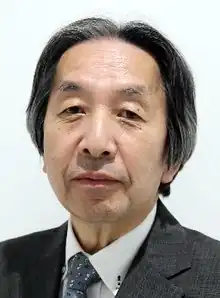原昌宏
原昌宏(日语:/ Hara Masahiro,1957年—)是一名日本工程師,因在1994年發明QR碼而知名[1][2]。
| 原昌宏 | |
|---|---|
 | |
| 出生 | 1957年(66—67歲) |
| 国籍 | |
| 知名于 | QR碼發明者 |
| 奖项 | 歐洲發明家獎(2014年) |
| 日語寫法 | |
|---|---|
| 日語原文 | |
| 假名 | |
| 平文式罗马字 | |
職業生涯

電裝和QR碼的發明
原昌宏在1980年畢業後,進入豐田集團的子公司電裝工作,從事條形碼系統的開發[6]。1992年,原昌宏被電裝公司的開發部門(後改組為Denso Wave)指派开发用於高效追踪汽車工業中使用的零件的新式條碼[7][8][9][10]。有一天工作時,在午休時間的圍棋遊戲中,他認知到圍棋的黑白布局可以用來編碼信息[6],他還通過針對印刷品的調查得出了適用於定位圖案的獨一無二的比例,從而防止解碼軟件誤讀[11]。該代碼於1994年作為QR碼推出[12]。
2021年,QR碼被用於預訂和追蹤COVID-19測試和聯繫人追踪[6]。原昌宏表示,他希望開發用於其他醫療目的的QR碼,包括X射線或心電圖數據等成像[2]。截至2022年,原昌宏仍為電裝公司工作[1]。
著作
獲獎
2014年,原昌宏和QR碼開發團隊的發明者們被授予歐洲發明家獎。[17]
參考資料
- . Worldcrunch. 2022-01-24 [2022-01-30]. (原始内容存档于2022-12-25) (英语).
- Oba, Yumi. . SBS Japanese. 19 November 2021 [2 February 2022]. (原始内容存档于2022-02-02).
- . www.ted.com. [2022-04-10]. (原始内容存档于2022-09-21).
- Hara, Mashhiro. (PDF). 2019 [2022-09-16]. (原始内容存档 (PDF)于2023-01-03).
- (PDF). Hosei University: Cover page. [2022-09-16]. (原始内容存档 (PDF)于2022-03-20).
"Hosei Alumnus, Masahire Hara invented QR code (1994) Denso Cp. Ltd. Graduated from Hosei University in 1980
- . the Guardian. 2020-12-11 [2022-09-16]. (原始内容存档于2022-12-18) (英语).
- Gapper, John. . Financial Times. 2020-10-30 [2022-01-30]. (原始内容存档于2022-10-03).
- . nippon.com. 2020-02-10 [2022-09-16]. (原始内容存档于2020-03-04) (英语).
- Boulton, J. (2014). 100 Ideas that Changed the Web. United Kingdom: Laurence King Publishing. Chapter 84 "This all changed in the early '90s at Denso Wave, a subsidiary of Toyota. An engineer called Masahiro Hara was tasked with creating a barcode that could hold more information than the existing format. His solution was the Quick Response (QR) code..."
- . www.proquest.com. [2022-03-20] (英语).
- . Denso Wave. [2023-04-30]. (原始内容存档于2023-04-19).
- Goodrich, Joanna. . IEEE Spectrum: Technology, Engineering, and Science News. [2022-09-16]. (原始内容存档于2021-06-29) (英语).
- Getting to Scale: How to Bring Development Solutions to Millions of Poor People. (2013). United States: Brookings Institution Press. p 296, 300
- . www.jica.go.jp. [2022-03-20].
- . Routledge & CRC Press. [2022-03-20]. (原始内容存档于2022-12-01) (英语).
- Maruyama, Takao; Kurosaki, Takashi. . World Development. 2021-12-01, 148: 105659 [2022-09-16]. ISSN 0305-750X. doi:10.1016/j.worlddev.2021.105659. (原始内容存档于2022-09-22) (英语).
- Office, European Patent. . www.epo.org. [2022-09-16]. (原始内容存档于2022-11-19) (英语).
This article is issued from Wikipedia. The text is licensed under Creative Commons - Attribution - Sharealike. Additional terms may apply for the media files.